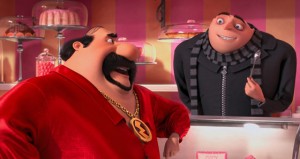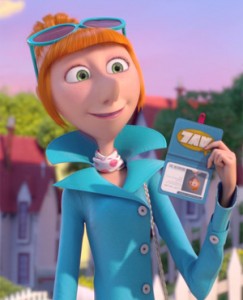Interview: Heitor Pereira, Composer of “Despicable Me 2”
Posted on July 5, 2013 at 9:00 am
Heitor Pereira is a Brazilian musician and composer who has gone from Simply Red to Hollywood, creating movie scores for films like “Madagascar,” “The Holiday,” and “Bee Movie.” He talked to me about the challenge of scoring a sequel with a very distinctive original theme, creating new themes for the new characters, which classic movie he’d like to have scored, and why it is important to “tease the ears.”
How did your conversation about this movie begin?
In the lines of, “Let’s not forget what we’ve done so far. Let’s pick it up from there and go with it. Musically, it means that the melodies for Gru and the girls that existed in the first one became slightly different because the emotions of those characters are different. That’s one of the beautiful things that fascinated me the most — you can keep creating new versions of the same thing. You can let the picture tell you what the style is, it will never end. And there were new characters. El Macho had the influence of Mexican music. Lucy had more of a tango. And the minions that become bad — their theme had to become more threatening and menacing.
I was glad to hear “Prettiest Girls” from the original again in the sequel. It’s perfect for the scene.
That’s how I got this movie. Pharrell had asked me to do an arrangement of the song to see how we could stretch it. This will be forever the melody of the girls. Every melody can be made different, kind of new to the ears, even though we are in the same movie, with the same notes. I love the way the melody can become so many different things.
Tell me more about creating new themes for the new characters.
 El Macho being like a Mexican wrestler, definitely I had to bring all that Mexican music with a bravado, him being a villain, it had to be strong and powerful and big. When Gru means business, he means business, and the villain has to be very strong to fight him. The music had to give us that strength. Mexican music is so colorful. It can be sad and in one second it can be completely joyful. And animation — that’s one of the things it asks from you most as a musician. You have to be able to turn sadness into laughter and happiness into tears. Characters like El Macho and Lucy give you enough emotional area to draw from because they change a lot in the story-telling. All that has to be told with the same melody but several variations. If you pick styles of music that have their essence — Mexican music you have mariachi, you have Veracruz, you have banda. For Lucy, I chose a tango. But a tango doesn’t necessarily have to be all serious, calculating. It can be emotional, in love, comedic.
El Macho being like a Mexican wrestler, definitely I had to bring all that Mexican music with a bravado, him being a villain, it had to be strong and powerful and big. When Gru means business, he means business, and the villain has to be very strong to fight him. The music had to give us that strength. Mexican music is so colorful. It can be sad and in one second it can be completely joyful. And animation — that’s one of the things it asks from you most as a musician. You have to be able to turn sadness into laughter and happiness into tears. Characters like El Macho and Lucy give you enough emotional area to draw from because they change a lot in the story-telling. All that has to be told with the same melody but several variations. If you pick styles of music that have their essence — Mexican music you have mariachi, you have Veracruz, you have banda. For Lucy, I chose a tango. But a tango doesn’t necessarily have to be all serious, calculating. It can be emotional, in love, comedic.
Is it a challenge to integrate songs into the score?
Unless there is a reason in the story, you don’t want it to be a surprise, so you have to tease the ears with what is going to come in the song before it begins. That’s why I love collaborating with pop artists, like I did with Jack Johnson in “Curious George.” It’s something I understand from my time with Simply Red and working as a session musician. It’s such a beautiful thing, it just completes the movie in such a special way, a special moment in the story-telling, not just plugging an artist. You have to feel that it is only that artist, only that song, that belongs in that moment and tells that part of the story. I love my job!
If you could go back in time and write a score for any classic movie, what would you pick?
I would pick a hard one. I would like to rewrite “The Mission.” It was from the perspective of the Jesuits and the conquistatdores. I would love to do it from the perspective of the indigenous peoples, because I am Brazilian. Or “The Third Man.” It was so minimalistic. What if it was done in another way?
How early do you get involved in a film like this?
Very early, I come in from the script onwards. I love seeing the process and how it evolves. We collaborate from the beginning on the score itself. I really appreciate the comments and suggestions and the yeses and nos from the producer and directors. I don’t fear comments. I expect them to have an opinion about what I’ve done and how can I make it better. The great bands are the bands that if you close your eyes you can visualize the musicians listening to each other. If the director is very open and very “what if?” and open to whatever can make it better, that is like working with a band.
When I am performing, I am fascinated by looking at the audience, thinking, “How is it affecting them.” Now, when I write in my lonely chair, in my dark room, I’m thinking, “this chair right now is one of a thousand chairs in the movie theater. If I was to look to my side, I would see the audience who have gone to the theater to see the movie and listen to this music that I’m adding to it.” You never forget that you are there to be part of this entertaining moment, for a family or a romantic story or a drama or to scare the hell out of people in a horror movie. Then you’re not lonely. You think about who you are making the music for. You’re writing for those ears and eyes six months later in the audience, in the crowd. A person should never forget that because you never run out of ideas.
